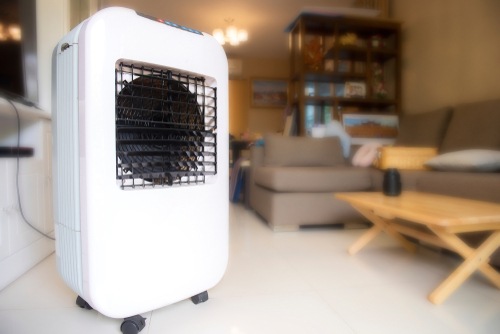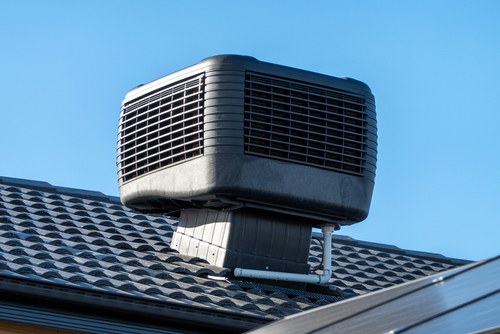At some point, we’ve all experienced ‘end of summer’ power bill shock, making reaching for the air con remote less and less appealing as the years go by. But when the temperature reaches sweltering and your pedestal fan struggles to do much of anything, you’re left with one less-obvious choice: evaporative cooling.
It’s the halfway point between air conditioning and a fan, using what’s essentially cool humidity to bring the temperature down in your house. But how much will it affect your power bill? This guide will break down the running costs and anything else you need to know about evaporative coolers.
On this page:
How much does it cost to run a portable evaporative cooler?
According to Canstar Blue data, the hourly usage cost of a portable evaporative cooler is 2.13 cents. Depending on the size of system, your electricity usage rate charged and the watts used per hours by the system, however, these costs may differ slightly.
In the table below, we’ve extended these costs over a four, six and eight hour usage period, as well as an assumed summer usage of eight hours a day for 90 days.
Portable evaporative cooler running costs (10L)
| Time Used | Electricity Usage Cost |
| 1 hour | 2.13c |
| 4 hours | 8.53c |
| 6 hours | 12.79c |
| 8 hours | 17.06c |
| Summer (8 hours/day, 90 days) | $15.35 |
Source: www.canstarblue.com.au – 1/11/2023. Electricity usage cost estimates based on the average electricity usage rate of 32.8 c/kWh. Average electricity usage rates are based on single rate, non-solar only plans on Canstar’s database, available for an annual usage of 4,347 kWh. Average energy consumption figures of 65W based on a selection of five 10L portable coolers, assume cooler is run at full capacity. Table presents estimated costs only, your situation will differ based on the unit’s specifications, required cooling capacity and how much the unit is used.
If you’re running an evaporative cooler in more than one room, you can add up the figures above to better reflect how much it will cost you. Keep in mind that these are just estimates and your actual costs will vary based on factors such as your individual energy rates.
How much does it cost to run a ducted evaporative cooler?
According to Canstar Blue data, it can cost between $0.14 and $0.35 to run a ducted evaporative cooler per hour, depending on the system size. Other factors such as electricity usage rates however, may also impact these costs.
Similar to the above, we’ve extended these running costs over a four, six and eight hour usage period, as well as an assumed summer usage of eight hours a day for 90 days. We’ve also broken these costs down by system capacity for further detail.
Ducted evaporative cooler running costs
← Mobile/tablet users, scroll sideways to view full table →
| Time Used | 5-10kW Capacity Ducted (413W) | 10-15kW Capacity Ducted (734W) | 15-20kW Capacity Ducted (1,064W) |
| 1 hour | $0.14 | $0.24 | $0.35 |
| 4 hours | $0.54 | $0.96 | $1.40 |
| 6 hours | $0.81 | $1.45 | $2.09 |
| 8 hours | $1.08 | $1.93 | $2.79 |
| Summer (8 hours/day, 90 days) | $97.20 | $173.70 | $251.10 |
Source: www.canstarblue.com.au – 1/11/2023. Electricity usage cost estimates based on the average electricity usage rate of 32.8 c/kWh. Average electricity usage rates are based on single rate, non-solar only plans on Canstar’s database, available for an annual usage of 4,347 kWh. Average energy consumption figures based on a selection of 36 ducted evaporative air conditioners and assume cooler is run at full capacity. Table presents estimated costs only, your situation will differ based on the unit’s specifications, required cooling capacity and how much the unit is used.
As you can see, using a ducted evaporative cooler system continuously over the summer will add up – but not nearly as much as air conditioning. Keep in mind that if where you are is hot and humid, a ducted evaporative cooler may not work as well as it would in a dry climate.
Stay on top of your summer bills! Compare cheap electricity plans now
Here are some of the cheapest published deals from the retailers on our database that include a link to the retailer’s website for further details. These are products from referral partners†. These costs are based on the Ausgrid network in Sydney but prices may vary depending on your circumstances. This comparison assumes general energy usage of 3900kWh/year for a residential customer on a single rate tariff. Please use our comparison tool for a specific comparison in your area. Our database may not cover all deals in your area. As always, check all details of any plan directly with the retailer before making a purchase decision.
Here are some of the cheapest published deals from the retailers on our database that include a link to the retailer’s website for further details. These are products from referral partners†. These costs are based on the Citipower network in Melbourne but prices may vary depending on your circumstances. This comparison assumes general energy usage of 4000kWh/year for a residential customer on a single rate tariff. Please use our comparison tool for a specific comparison in your area. Our database may not cover all deals in your area. As always, check all details of any plan directly with the retailer before making a purchase decision.
Here are some of the cheapest published deals from the retailers on our database that include a link to the retailer’s website for further details. These are products from referral partners†. These costs are based on the Energex network in Brisbane but prices may vary depending on your circumstances. This comparison assumes general energy usage of 4600kWh/year for a residential customer on a single rate tariff. Please use our comparison tool for a specific comparison in your area. Our database may not cover all deals in your area. As always, check all details of any plan directly with the retailer before making a purchase decision.
Here are some of the cheapest published deals from the retailers on our database that include a link to the retailer’s website for further details. These are products from referral partners†. These costs are based on the SA Power network in Adelaide but prices may vary depending on your circumstances. This comparison assumes general energy usage of 4000kWh/year for a residential customer on a single rate tariff. Please use our comparison tool for a specific comparison in your area. Our database may not cover all deals in your area. As always, check all details of any plan directly with the retailer before making a purchase decision.
What impacts evaporative cooler running costs?
Here are a few things that may affect how much you’ll need to pay for evaporative cooling:
- External environment: In particular environments, your evaporative cooler may need more grunt to work. Keep in mind that in humid areas, this cooling method may be ineffective.
- Number of rooms: It’s not rocket science, but the more rooms you have to cool, the more money you’ll need to pay. Keep costs down by only running your system in rooms you’re presently using.
- Your evaporative cooling system: A portable system will cost significantly less to purchase and run than ducted, but with lower costs comes reduced effectiveness.
- Your energy rates: It may not be directly linked with your system, but someone paying cheaper rates for their power will naturally pay less to run their evaporative cooler than someone on higher rates.
On the fence about evaporative cooling? See whether it’ll suit you better than standard air conditioning in Canstar Blue’s air conditioners vs evaporative coolers analysis now.
How to save on evaporative cooler running costs
The key to saving on cooling is understanding how much it will cost you to run your machine. There’s no shortcut to saving on running costs, but by knowing that anything from the size of your room to the capacity of your system can contribute to how expensive your system will be, you’ll be less likely to fall into any traps.
While giving your system a good clean will no doubt keep it performing to its max energy efficiency, it’s how much you pay in electricity rates that will contribute the most in this case. Now’s a good of a time as any to refresh your power plan to ensure you’re on the best possible deal.
Image credits: alexandre zveiger/shutterstock.com, yangtak/shutterstock.com, Michael Ronin/shutterstock.com







Share this article